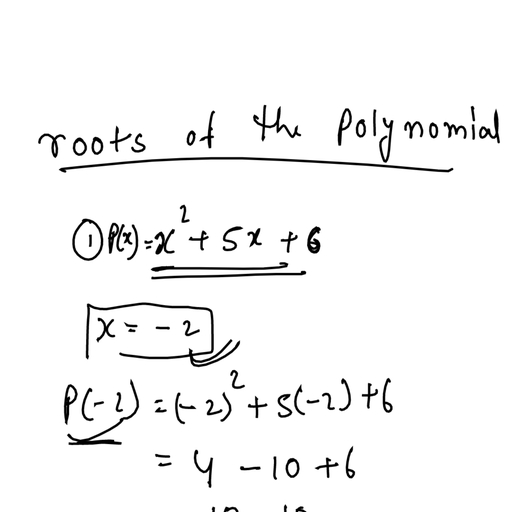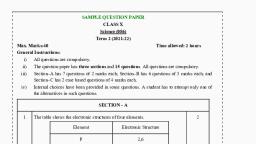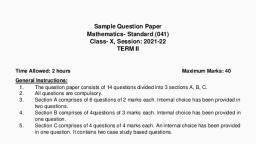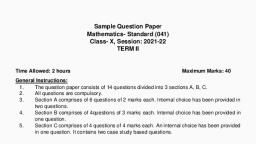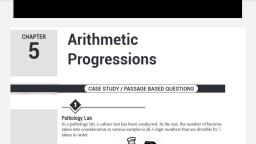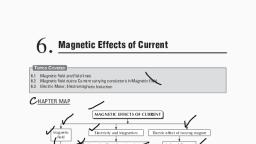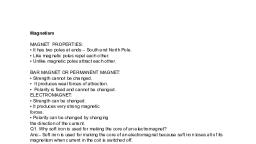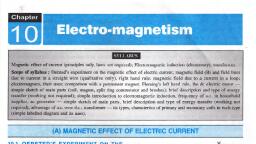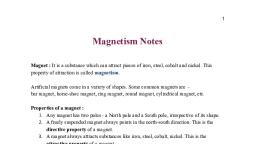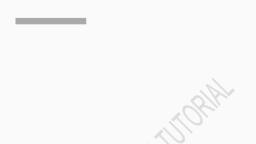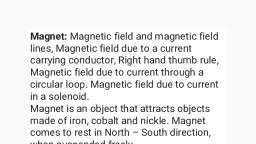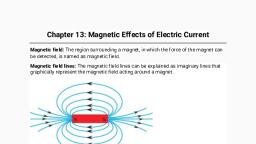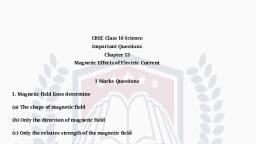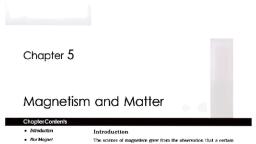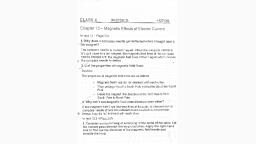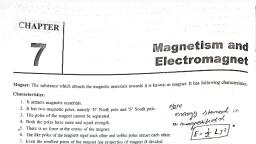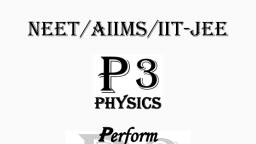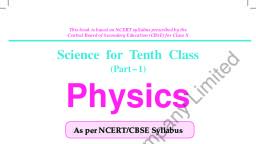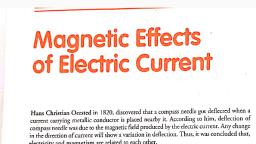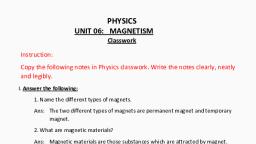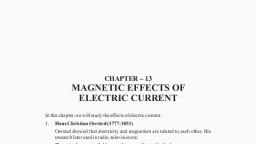Page 1 :
CHAPTER 1 3, MAGNETIC EFFECT OF CURRENT, The term magnetic effect of eectric current means that an electric current flowing in a, , wire produces a magnetic field around it., A current flowing in a wire always gives rise to a magnetic field around it. The, , magnetic effect of current is also called electromagnetism which means electricity, produces magnetism. In figure, the deflection of compass needle by the current, carrying wire in the below experiment show that an electric current produces a, , magnetic field around it., R, , K, , ww, , MAGNET, , A magnet is an object, which attracts pieces of iron, steel, nickel and cobalt. It has two, poles at ends - South and North Pole., , Like magnetic poles repel each other., Unlike, , magnetic poles attract each other, , MAGNETIC FIELD, The space surrounding a magnet in which the force of attraction and repulsion is, , exerted is called a magnetic fiekd., MAGNETIC FIELD LINES, The magnetic field lines are the lines drawn in a magnetic field along which a north, magnetic pole would move. These are also known as magnetic lines of forces., PROPERTIES OF MAGNETIC FIELD LINES, 1. A magnetic field lines originate from north pole and end at its south pole., 2. A magnetic field line is a closed and continuous curve., 3. The magnetic field lines are closer near the poles of a magnet where the magnetic, field is strong and farther apart where the magnetic field is weak., 4. The magnetic field lines never intersect each other., 5. A uniform magnetic field is represented by parallel and equidistant field lines.
Page 2 :
INTEXT, QUESTIONS PAGE NO. 224, 1. Why does a compass needle get deflected when brought near a bar magnet?, Ans. A compass gets deflected due to the forces acting on its poles due to the, , magnetic field of the bar magnet., , MAGNETIC FIELD DUE TO A CURRENT THROUGH A STRAIGHT, CONDUCTOR, The magnetic field lines around a straight conductor carrying current are concentric, circles whose centres lies on the wire., , The magnitude of magnetic field produced by a straight current carying wire at a, , point, directly proportional to, , current, , passing, , in the wire., , inversely proportional to the distance of that point from the wire., Variable, , resistance, , K, , RIGHT-HAND THUMB RULE, When a current-carrying straight conductor is holding in right hand such that the, thumb points towards the direction of current. Then fingers will wrap around the, conductor in the direction of the field lines of the magnetic field, as shown in below, figure. This is known as the right-hand thumb rule, , Elcctric current, , B, , T, , Magnetic field, , B
Page 3 :
Thumb-points in the direction of current then direction of fingers encircle the wire, give the direction of magnetic field around the wire., , INTEXT, QUESTIONS PAGE NO,228, 1. Draw magnetic field lines around a bar magnet., Ans., , 2. List the properties of magnetic lines of force., Ans. Refer in page no. I, , 3. Why don't two magnetic lines of force intersect each other?, Ans. If two magnetic lines of force intersect then there would be two directions of, magnetic field at that point, which is absurd. That is why they never intersect., , MAGNETIC FIELD DUE TO A CURRENT THROUGH A CIRCULAR LOOP, The magnetic field lines are circular near the current carrying loop. As we move, , away, the concentric circles becomes bigger and bigger. At the centre, the lines are, , straight., , At the centre, all the magnetic field lines are in the same direction due to which the, strength of magnetic field increase., The magnetic of magnetic field produced by a current carrying circular loop at its, centre is, , directly proportional to the current passing, inversely proportional to the radius of the circular loop, The strength of magnetic field produced by a circular coil carrying current is directly, proportional to both number of turns(n) and current(1) but inversely proportional to its, , radius(r).
Page 4 :
Circular colil, carrying current, , Magnetic lines, of force, MAGNETIC FIELD DUE TO A CURRENT IN A, The insulated copper wire wound ona cylindrical tube such that its length is greater, than its diameter is calleda solenoid. The solenoid is from greek word for channel., The solenoid is a long coil containing a large number of close tums of insulated, , SOLENOID, , copper wire., current, field produced by, Themagnetic, magnetic, field produced by a bar magnet., a, , carrying, , solenoid is similar to the, , The current in each turn of a current carrying solenoid flows in the same direction, due to which the magnetic field produced by each turn of the solenoid ads up., giving, , a, , strong magnetic field inside the, , solenoid., , The strong magnetic field produced inside a current-carrying solenoid can be used to, , magnetise a piece of magnetic material like soft iron, when placed inside the solenoid., The magnet thus formed is called an electromagnet., , So, a solenoid is used for making electromagnets., The strengh of magnetic field produced by a carrying current solenoid depends on, number of turns(n), , strength ofcurrent(), , nature of core material used in solenoid, produces the strongest magnetism, , use of soft iron as core in a solenoid
Page 5 :
ELECTROMAGNETS, , An electromagnet is, on soft iron core., , a, , AND, , PERMANENT MAGNETS, , and is, temporary strong magnet, , just, , has, made from steel. As steel, A permanent magnet is, , a, , solenoid with its, , more, , winding, , retentivity than iron, it, , does not lose its magnetism easily., , magnet, Diference between Electromagnet and permanent, Permanent magnet, Electromagnet, , I., , An, , electromagnet, it, , can, , by stopping, , the, , magnet, , as, , Is, , a, , temporary, , readily demagnetized, current through the, , solenoid., It, , produces very strong magnetic, , forces., 4., , Polarity, , can, , be, , permanent magnet, readily demagnetized., A, , cannot, , be, , 2. Strength cannot be changed., , 2. Strength can be changed., 3., , 1., , changed by changing, , thedirection of the current., , 3., , It, , produces, , weal, , forces, , of, , cannot, , be, , attraction., , |4. Polarity, , is, , fixed, , and, , changed., , making the core of an electromagnet2, iron is used forthe, soft, 0. Why, core of, electromagnet because sofi iron loses all of, iron is, an, making, for, used, its magnetism when current in the coil is switched off., , Sofi, , the core ofan electromagnet?, 0. Why steel is not used for making, the core of, electromagnet because steel does not loses, Steel is, , not, , used for, , an, , making, , all of its magnetism when current in the coil is switched of., , INTEXT, OUESTIONS PAGE NO.229 and 230, 1. Consider a circular loop of wire lying in the plane of the table., through the loop clockwise. Apply the right-hand, , rule, , to, , Let the current pass, , find out the direction of, , the magnetic field inside and outside the loop., For downward direction of current flowing in the circular loop. the direction of, magnetic field lines will be as if they are emerging from the table outside the loop, and merging in the table inside the loop. Similarly, for upward direction of current, , flowing in the circular loop, the direction of magnetic field lines will be as if they, are emerging from the table outside the loop and merging in the table inside the, , loop, as shown in the given figure., Circular loop of wire, carrying curent, , Upward field, lines, , Upward field, Tines, , Downward., , Downward, , field lines, , field lines
Page 6 :
2. The magnetic field in a given region is uniform. Draw a diagram to represent it., , 3. Choose the correct option: The magnetic field inside a long straight solenoidcarrying current (a) is zero. (b) decreases as we move towards its end. (c), increases as we move towards its end. (d) is the same at all points., The magnetic field fora point inside a long straight solenoid carrying current is, , double than for a point situated at one of its ends. Thus, the corect option is (b)., FORCE ON A CURRENT-CARRYING cONDUCTOR IN A MAGNETIC, FIELD, When a current carrying conductor is placed in a magnetic field it experiences a force,, except when it is placed parallel to the magnetic field., The force acting on a current carrying conductor in a magnetic field is due to, , interaction between:, 1. Magnetic force due to current-carrying conductor and, 2. External magnetie field in which the conductor is placed., , In the above figure, a current-carrying rod, AB, experiences a force perpendicular to, its length and the magnetic field., The displacement of the rod in the above activity suggests that a force is exerted on, the current-carrying aluminium rod when it is placed in a magnetic field. It also, , suggests that the direction of force is also reversed when the direction of current, through the conductor is reversed. Now change the direction of field to vertically, downwards by interchanging the two poles of the magnet. It is once again observed, that the direction of force acting on the current-carrying rod gets reversed. It shows, , that the direction of the force on the conductor depends upon the direction of current, and the direction of the magnetic field. We considered the direction of the current and, that of the magnetic field perpendicular to each other and found that the force is, perpendicular to both of them., , FLEMING'S LEFT HAND RULE, Fleming's left hand rule (for electric motors) shows the direction of the thrust on a, , conductor carrying a current in a magnetic field. The left hand is held with the thumb, index finger and middle finger mutually at right angles., The First finger represents the direction of the magnetic Field. (north to south)
Page 7 :
The Second finger represents the direction of the Current (the direction of the current, , negative)., , is the direction of conventional current; from positive to, The Thumb represents the direction of the Thrust or resultant Motion., , Direction, , of Force, , Maonetic, Field, , Direction, of Current, FLEMING'S RIGHT HAND RULE, , Fleming's right hand rule (for generators) shows the direction of induced current when, a conductor moves in a magnetic field., , The right hand is held with the thumb, first finger and second finger mutually, perpendicular to each other {at right angles), as shown in the diagram., The Thumb represents the direction of Motion of the conductor., The First finger represents the direction of the Field. (north to south), The Second finger represents the direction of the induced or generated Current (the, direction of the induced current will be the direction of conventional current; from, positive to negative)., Magnetic, field, , Motion of the conductor, , Thumb, , Forefinger, , Induced curent, , Middle finger, , INTEXT QUESTIONS PAGE NO. 231 AND 232, , 1. Which of the following property of a proton can change while it moves freely in a, , magnetic field? (There may be more than one correct answer.) (a) mass (b) speed, , (C) velocity (d) momentum
















